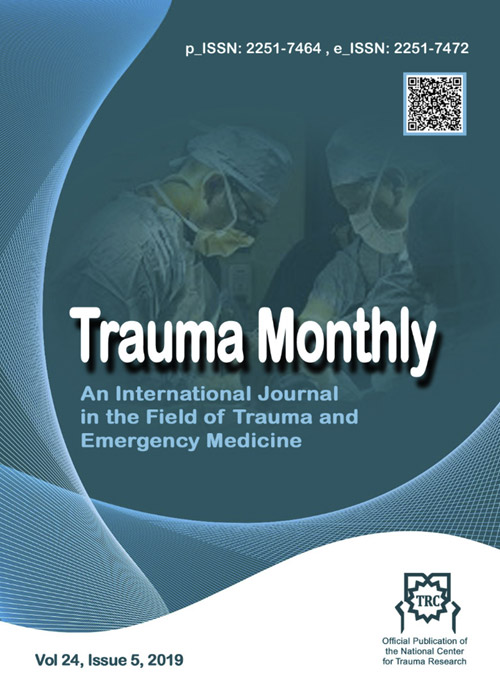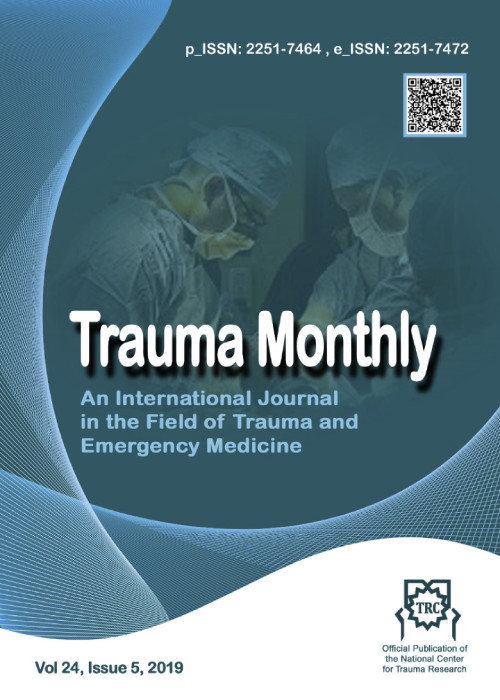فهرست مطالب

Trauma Monthly
Volume:26 Issue: 6, Nov-Dec 2021
- تاریخ انتشار: 1400/11/09
- تعداد عناوین: 8
-
-
Pages 294-304Introduction
Traffic injuries are one of the main causes of death worldwide. After decreasing mortality rates and improving the recovery of injured patients, long-term functional consequences need to be addressed. The purpose of this study was to assess the functional outcomes of road traffic injuries and their predictors six months after hospital discharge, based on the preliminary results from PTC.
MethodsA cross-sectional study based on PERSIAN Traffic Health and Safety Cohort Study was performed. Data were collected using the 12-item World Health Organization Disability Assessment Schedule 2.0 (WHODAS 2.0) with six domains (cognition, mobility, self-care, getting along with others, life activities, and participation), filled-in by 180 injured adults (age >18 years) at six-month follow-up after hospital discharge during October 2019. These patients were hospitalized after road accidents at two referral trauma centers, (from 23 September 2018 to 20 March 2019).
ResultsThe majority of participants were men (82.7%), (Mean age =38.8). The mean score of WHODAS 2.0 was 17.8) SD=9.1). The highest score was estimated for the self-care dimension 3.3 (SD=1.8), and the lowest score for getting along with others 2.4 (SD=1.2). Age, gender, physiotherapy, injury localization including head and face, spinal cord, and upper extremity were predictors of WHODAS 2.0 score in various dimensions (p<0.05).
ConclusionThe current study identified some functional disabilities among patients sustaining road traffic injuries. It is evident from the results that a proportion of patients do not recover six months after the injury and suffer a disability, especially in self-care, mobility, and life activities, which potentially prevent them from returning to normalcy. In addition, age, gender, physiotherapy, injury localization was related to WHODAS 2.0 scores.
Keywords: Accidents, road traffic injury, Traffic Accidents, functional status, WHODAS 2.0, Cohort studies -
Pages 305-310IntroductionUse of tampons is one of the most common ways to treat epistaxis. This single Randomized clinical trial aimed to assess the efficiency of tranexamic acid (TA) in controlling different types of bleeding.MethodsFrom 2019 to 2020, 120 patients with epistaxis, referred to the Imam Reza Hospital(Tabriz-Iran) emergency department, and were treated. The patients were randomly divided into control (tampon) and intervention (TA) groups. The control group received tetracycline-impregnated tampon, while TA-impregnated gauze was used for the intervention group.ResultsThe mean time needed to stop bleeding was significantly higher (p=0.011) in the control group (18.59±2.33 Min) than in the intervention group (09.33±1.47 Min). In most patients in the intervention group bleeding stopped in less than 10 minutes; while in the control group. Bleeding in the majority of patients ceased within 10 to 20 minutes (p=0.01).ConclusionThe results indicate the beneficial effects of TA, as a drug with relatively low side effects in reducing bleeding time in patients with epistaxis. Thus, it can be used as a complementary drug, along with packing to stop bleeding.Keywords: Bleeding, Tranexamic acid, Epistaxis, Emergency
-
Pages 311-316IntroductionIn major operations such as hip surgery, the volume of blood loss is high, and patients require blood transfusion. The current study aimed to assess the effect of Tranexamic Acid on reducing blood loss and the need for blood transfusion during and after surgery.MethodsAssessed patients with concher femoral insertion surgery were randomly divided to intervention and control groups. After anesthesia, the intervention group received Tranexamic Acid (10 mg/kg) 15 minutes before infusion. The infusion was performed at a rate of 1 mg/kg/hr until the end of surgery. In the control group, equal volumes of normal saline were used.ResultsThe mean blood loss during surgery was 1081.67±298.70 cc in the placebo group; and was 557.00±00.76 cc in the intervention group. The mean blood loss during surgery was significantly higher in the placebo group than in the intervention group (P<0.001). The mean blood loss after surgery was 427±000.7032 in the placebo group, and was 249.67±66.37 in the control group (P<0.001). Blood transfusion, during and after surgery was significantly different between the two groups (P<0.001).ConclusionSingle dose Tranexamic Acid (10 mg/kg) 15 minutes before the infusion to patients scheduled for femoral fracture surgery can reduce blood loss and the need for blood transfusion during and after surgery.Keywords: Femoral Fracture, Blood loss, Blood transfusion, Tranexamic acid
-
Pages 317-321IntroductionA series of criteria are developed to assess the patients' severity of illness in the ICU. Acute Physiology and Chronic Health Evaluation (APACHE) is a widely used scoring system (SS). The current study aimed to determine the difference between APACHE II and APACHE IV scoring systems in predicting mortality rate and length of hospital stay in patients with head trauma referred to Poursina Hospital in Rasht.MethodsIn this retrospective analytical study, medical records of patients hospitalized due to head trauma in the ICU of Poursina Hospital from February 25, 2009, to August 21, 2019, were studied.ResultsThe mortality rate of 1472 ICU patients was 39.3%. The predicted mortality rate by the APACHE II SS before and after surgery was 28.7% and 12.8%, respectively; While APACHE IV predicted 39% of deaths. The mean hospitalization duration of patients was 15±41.35 days. Also, the mean ICU hospitalization was 9.77±9.24 days. Although, the mean estimated length of stay based on APACHE IV was 6.23 67±.8 days. The APACHE IV SS underestimated the length of stay (p<0.001). According to the ROC chart, the best cut-off for APACHE IV was 66, with a sensitivity of 85.8% and specificity of 85.4%. For APACHE II, the best cut-off score was 20 with a sensitivity of 86.4% and specificity of 81.3%.ConclusionBoth APACHE II and APACHE IV SS can be used to predict the mortality of ICU patients, but APACHE IV is more effective and more accurate.Keywords: APACHE II, APACHE IV, Mortality rate, Length of Hospital Stay, Head trauma
-
Pages 322-329IntroductionCarpal tunnel syndrome (CTS) is a symptomatic compression neuropathy of the median nerve in the wrist. The purpose of this comparative study was to evaluate the clinical outcomes of median nerve release in CTS with and without cervical radiculopathy (CR) in patients referred to orthopedic research centers in Sari, Iran, to answer the question of whether the CR patients need to be referred for proximal decompression spine surgery.MethodsThe patients were selected in two groups of 30 patient (CTS with and without cervical radiculopathy). The patients in the CR group were selected based on involvement in electromyography (EMG)/nerve conduction velocity (NCV). This study examined the variables of grip and pinch strength, QuickDASH questionnaire, Boston symptom severity scale (BQ-SS), Boston Questionnaire-Functional Scale (BQ-FS) and VAS index before surgery, three months and six months after surgery.Resultsthe scores of grip and pinch strength, BQ-FS and BQ-SS, QuickDASH and VAS had a significant decrease in three months and six months after surgery compared to before surgery between the two groups (P<0.05). There was no significant difference between the two groups in terms of reduction rate (P>0.05). The results of repeated measures ANOVA test also showed that the correlation between BQ-SS and VAS in patients according to the study groups in different time periods is significant, so that BQ-SS and VAS scores decreased after median nerve release in both groups but the decrease trend was significantly higher in the CTS group without CR than in the CTS group with CR (P<0.001).Conclusionit can be concluded that the median nerve release can be effective in two groups, and six-month follow-up in patients with CR revealed that there is no need for referral for proximal decompression spine surgeryKeywords: carpal tunnel syndrome, Median Nerve, median nerve release
-
Pages 330-334
Venous resection and reconstruction are common during pancreaticoduodenectomy due to pancreatic adenocarcinoma. Multiple treatment options have been offered for venous injury repair. In this regard, the present study used the peritoneum as a conduit for the superior mesenteric vein (SMV) reconstruction during colon cancer surgery. The case was a 55-year-old woman with colon adenocarcinoma. The SMV damage was 6 cm in length. The defect was replaced with peritoneal conduit derived from parietal peritoneum of the abdominal wall. Coalition and flow of the SMV were confirmed by contrast-enhanced computed tomography examinations. The patient had a good condition over the six-month follow-up period. Peritoneal conduit might be a promising choice for SMV defects in emergent conditions due to its availability and lower overall costs.
Keywords: Peritoneal conduit, Superior mesenteric vein, Colon cancer, Krukenberg tumor -
Pages 335-339
A 65-year-old farmer fell from a three-meter-high tree and sustained a palmar-divergent dislocation of the scaphoid and lunate. The patient was treated with open reduction of the scaphoid and lunate through the volar approach. The volar wrist capsule including the radioscaphocapitate ligament and Poirier space were repaired, and the scapholunate joint was fixed with two K-wires. Palmar-divergent dislocation of the scaphoid and lunate suggests a more severe injury to the soft tissue and ligaments of the wrist than a Mayfield stage IV perilunate dislocation. It seems that Mayfield's classification on perilunate injuries can be extended to include palmar-divergent dislocation of the scaphoid and lunate as type V.
Keywords: Palmar-divergent dislocation, perilunate injury, lunate dislocation, scaphoid dislocation, wrist dislocation -
Pages 340-348Introduction
The results of various studies on the preventive effect of knee brace on anterior cruciate ligament (ACL) injuries in susceptible individuals vary; leading to doubts about their utilization for orthopedic specialists. The present study aimed to review the preventive effects of knee brace on ACL injuries in susceptible individuals.
MethodsThis systematic review was performed using the keywords "Prophylactic Knee Brace, Neoprene Knee Sleeve, Knee Brace, ACL, Tear Risk Factors, and Biomechanical Factors" in online databases such as PubMed, Scopus, Springer, ProQuest, and the Google Scholar search engine. The I2 index was used to assess heterogeneity among studies.
ResultsA total of eight high-quality articles were assessed all represented moderate heterogeneity (I2 index: 25%-75%). Only one study reported the ineffectiveness of knee brace in preventing ACL injuries, and the rest noticed positive effects.
ConclusionThe use of a prophylactic knee brace in individuals susceptible to ACL rupture can avoid sustaining pressure and possible damage to the knee and ACL.
Keywords: Anterior Cruciate Ligament (ACL) Injury, Functional Knee Brace, Prevention


